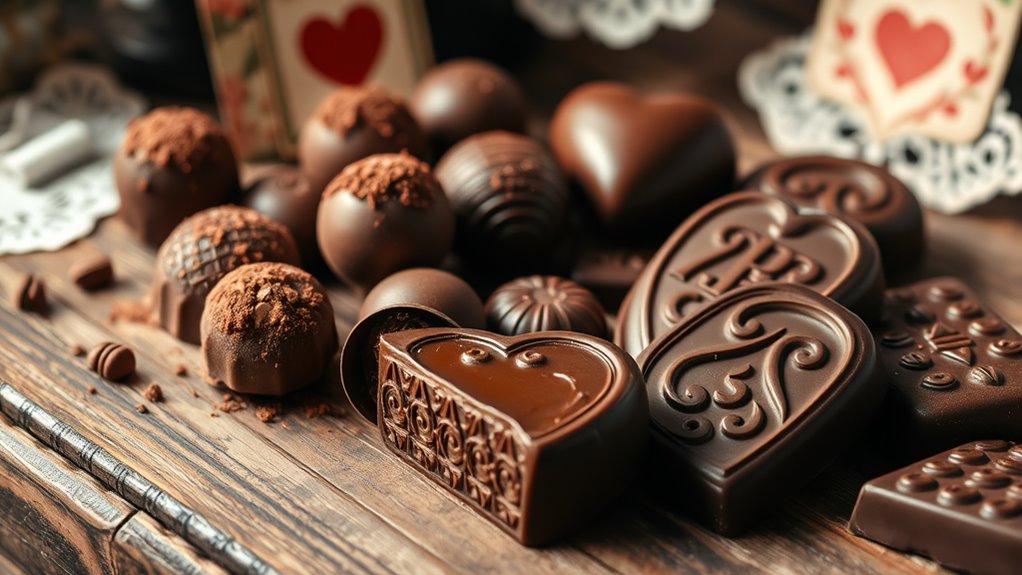Chocolate’s history on Valentine’s Day traces back to ancient Mesoamerican rituals where cacao symbolized divine favor and romance. When Europeans introduced cacao to Europe, it became a luxury item associated with love and fertility. Over time, chocolates started symbolizing affection, especially during the modern celebration of Valentine’s Day, often as gifts of love. From sacred origins to widespread commercialization, this romantic connection continues to evolve—exploring more reveals how chocolate’s romantic story shaped traditions around the world.
Key Takeaways
- Chocolate’s association with love and romance was popularized during the 19th century, especially as Valentine’s Day gift options.
- The tradition of giving chocolates on Valentine’s Day evolved from luxury gifts to symbols of affection.
- Heart-shaped boxes and romantic packaging became common marketing tools to promote chocolates as love tokens.
- Cultural practices, like personalized messages and artisanal chocolates, enhanced Valentine’s Day gifting traditions.
- The romantic symbolism of chocolate is rooted in its historical ties to fertility, luxury, and divine qualities from ancient Mesoamerican cultures.
The Origins of Chocolate in Ancient Civilizations
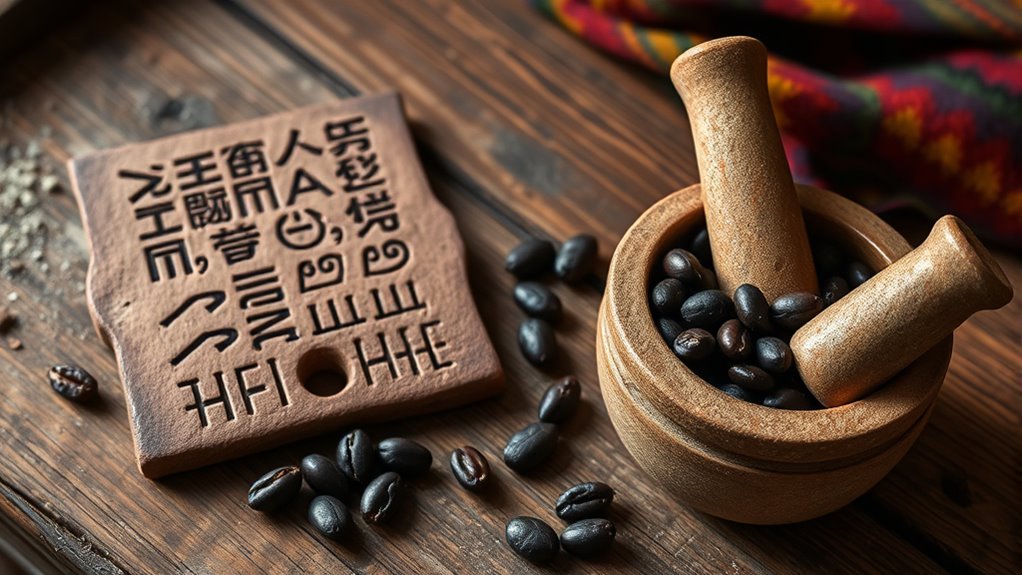
Chocolate has a rich history that dates back thousands of years, beginning with ancient civilizations in Central and South America. You can trace its origins to the Olmec, who first cultivated cacao around 1500 BCE, recognizing its value long before it became a global commodity. The Mayans and Aztecs further developed cacao’s significance, using it in rituals and as currency. They prepared a bitter, frothy beverage called “xocolatl,” which was highly prized and believed to have divine qualities. As you explore its early history, you’ll see how cacao was intertwined with spiritual practices and social status. These civilizations understood the importance of cacao, setting the stage for its later journey into European culture and, eventually, Valentine’s Day traditions.
Chocolate’s Role in Mesoamerican Rituals and Ceremonies
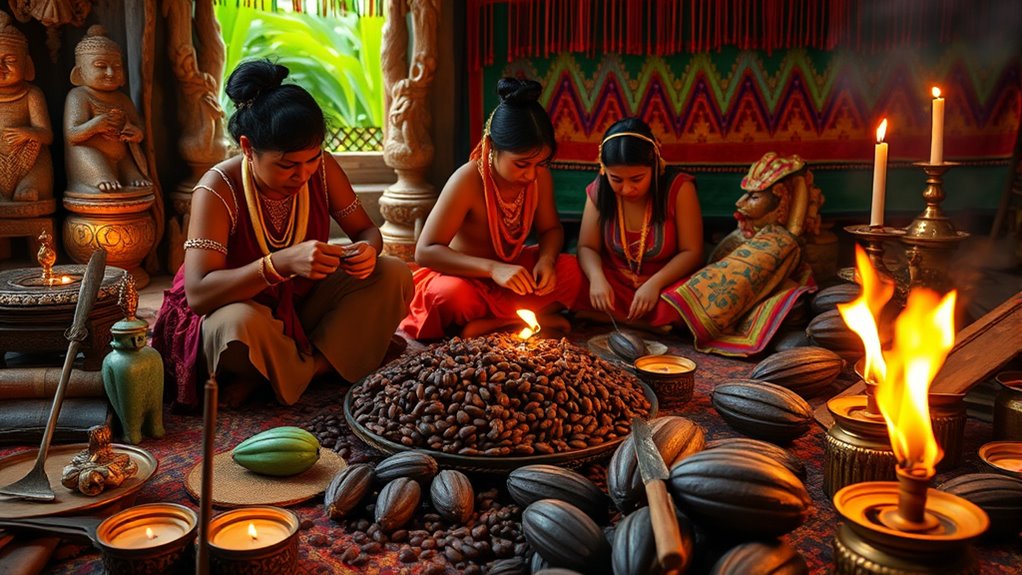
In Mesoamerican societies, cacao held a sacred place and played a vital role in rituals and ceremonies that reinforced social and spiritual bonds. You might have seen cacao beans offered to gods or used as currency in religious transactions. During rituals, participants often consumed cacao to invoke divine favor, guarantee fertility, or mark important life events. Priests and rulers used cacao in ceremonial drinks, believing it connected them to the spiritual realm. The Aztecs, for instance, regarded cacao as a gift from the gods, reserving it for nobility and sacred occasions. These rituals elevated cacao beyond a simple commodity, transforming it into a symbol of divine power and spiritual connection. The significance of cacao in these ceremonies underscores its sacred status within Mesoamerican culture and its enduring legacy in modern traditions. Additionally, the cultural significance of cacao helped preserve its importance across generations, maintaining its role in spiritual and social practices. The aura of cacao, both literal and symbolic, contributed to its revered status in these ceremonies. Furthermore, the spiritual symbolism associated with cacao reinforced its role as a bridge between humans and the divine, emphasizing its importance beyond the physical realm. The deep cultural roots of cacao are also reflected in the traditional art, such as intricate pottery and carvings, that depict its sacred role in society.
The Arrival of Chocolate in Europe and Its Luxury Status

When Spanish explorers returned from the Americas, they brought cacao beans and knowledge of their ceremonial use with them. Suddenly, chocolate became a rare and luxurious commodity in Europe. Initially, it was enjoyed mainly by royalty and wealthy elites who valued its rich flavor and supposed health benefits. You might be surprised to learn that:
Spanish explorers brought cacao to Europe, turning chocolate into a rare, luxury item for royalty and elites.
- Chocolate was initially a bitter drink, often flavored with spices and sugar.
- It was considered a status symbol among aristocrats.
- European traders fiercely guarded its exclusivity.
- Chocolate’s cost made it accessible only to the upper classes.
- It was used as currency in some regions.
- Its cultural significance grew as it became associated with luxury and prestige across European societies.
- The European fascination with chocolate led to the development of early confectionery innovations that increased its appeal.
- As demand increased, artisanal chocolate-making techniques developed to meet the growing appetite for sweetened varieties.
- The limited availability and high cost of chocolate contributed to its reputation as a luxury good, further elevating its status among the wealthy.
- Additionally, advancements in processing techniques helped improve the flavor and texture of chocolate, making it more desirable.
This limited availability transformed chocolate into a symbol of wealth and power, setting the stage for its romantic reputation centuries later.
The Transformation of Chocolate Into a Romantic Gift
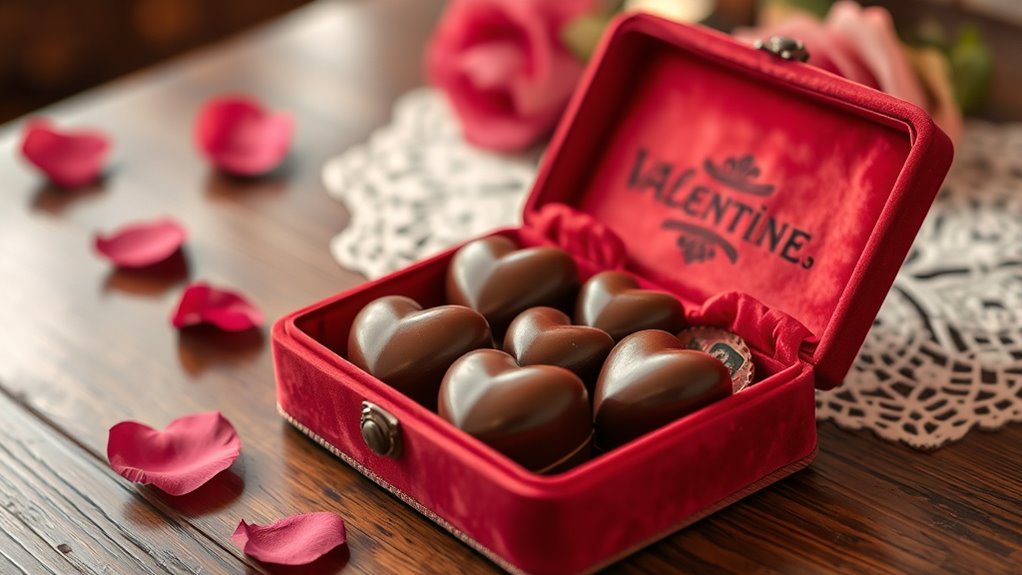
Although chocolate once symbolized wealth and power, it gradually became a popular way to express love and affection. In the 19th century, companies began marketing chocolates as romantic gifts, associating them with feelings of love and desire. Confections like heart-shaped boxes and elegantly wrapped chocolates emerged, especially around Valentine’s Day. You started to see chocolates as more than treats; they became symbols of romance and intimacy. Advertisements emphasized gifting chocolates to loved ones, reinforcing their emotional significance. This shift helped embed chocolates into Valentine’s Day traditions worldwide. You now often gift chocolates to show affection, making them a universal token of love. Their evolution from luxury item to romantic gesture continues to shape how people celebrate love on this special day. Additionally, the use of color symbolism in chocolate packaging further enhanced their romantic appeal. Furthermore, the research supporting the emotional impact of chocolates has contributed to their enduring popularity as romantic gifts. The incorporation of skincare-inspired marketing strategies by brands has also helped deepen the connection between chocolates and feelings of love and care. Recognizing the cultural significance of gifts, marketers leveraged emotional connection to deepen the romantic symbolism of chocolates.
The Influence of Literature and Art on Chocolate’s Romantic Image
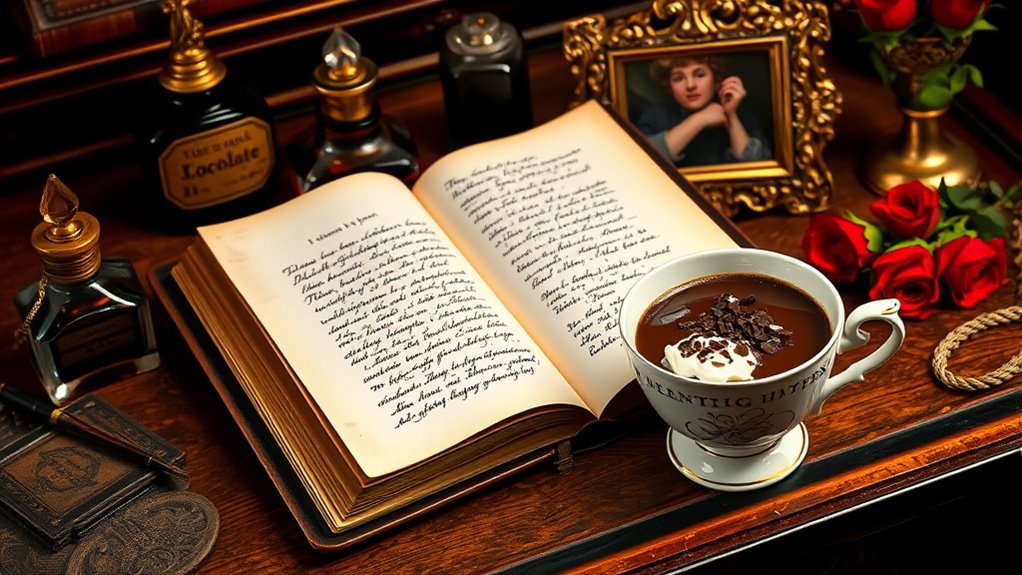
As chocolate cemented its place as a romantic gift through marketing and tradition, artists and writers began to elevate its symbolic power. They portrayed chocolate as a token of love, passion, and desire, shaping its romantic image in cultural consciousness. Literature often depicted chocolate as an indulgence shared between lovers, amplifying its sensual appeal. Visual art showcased chocolates in intimate scenes, reinforcing its association with romance. This influence encouraged people to see chocolate not just as a treat but as a meaningful gesture of affection. To deepen this connection, artists and writers:
Artists and writers transformed chocolate into a symbol of love and passion through evocative imagery and storytelling.
- Created paintings emphasizing romantic intimacy with chocolate
- Wrote poetry celebrating chocolate’s seductive qualities
- Illustrated scenes of lovers exchanging chocolates
- Used chocolate imagery in advertisements to evoke desire
- Integrated chocolate into romantic symbolism across mediums
- Knowledge of cultural symbolism and marketing helped artists and marketers craft compelling romantic messages involving chocolate. Additionally, the historical context of chocolate’s romantic status contributed to its enduring appeal across different cultures and eras. Furthermore, the visual representation of romance in art and media played a crucial role in solidifying its romantic image over time. Recognizing the impact of popular culture on shaping perceptions, creators continued to reinforce chocolate’s romantic symbolism through various modern adaptations.
The Evolution of Valentine’s Day Traditions and Chocolate’s Place
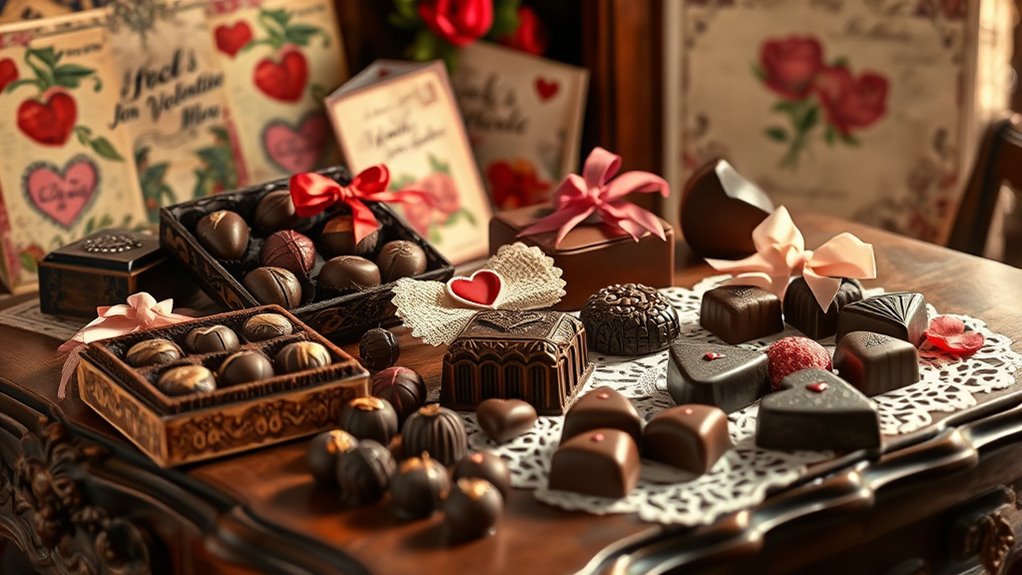
You’ve likely noticed how gift-giving has evolved on Valentine’s Day, with chocolates becoming a central symbol of love. These traditions reflect deeper cultural meanings and romantic ideals that have shifted over time. Exploring how chocolate became a staple reveals its lasting role in expressing affection and connection. The history of chocolate in celebrations also includes its evolution from a luxury item to a widely accessible gift. Understanding how creative practice influences the way people share and cherish chocolates can offer additional insight into these enduring traditions. Additionally, the health benefits associated with certain types of honey, like rapeseed or pine honey, demonstrate how natural products have long been valued for their positive effects on well-being and can be intertwined with cultural gift-giving practices. Furthermore, the cultural significance of chocolates in different societies highlights how this sweet treat has become a universal symbol of love and appreciation. Over time, marketing strategies have played a crucial role in popularizing chocolates as the ideal romantic gift, shaping modern customs.
Romantic Gift-Giving Trends
Over the years, the way people express their love through gift-giving on Valentine’s Day has evolved considerably, and chocolate has become a central symbol of romance. Today, giving chocolates is more than tradition; it’s a meaningful gesture. You might notice trends like personalized chocolates with custom messages, luxury assortments, or artisanal creations that reflect individual tastes. The rise of online shopping also allows you to choose unique, handcrafted boxes or subscription boxes for ongoing surprises. Additionally, many prefer sustainable, ethically sourced chocolates, aligning love with social responsibility. Diverse beach experiences] and cultural influences can also inspire innovative gift options for special occasions.
Symbolism and Cultural Links
Ever wondered how chocolates became a symbol of love on Valentine’s Day? It all ties to their historical association with luxury, fertility, and romance. In ancient cultures, cacao was believed to have aphrodisiac qualities, enhancing passion and desire. By the 19th century, chocolates started symbolizing affection, especially as they became more accessible through mass production. Over time, chocolates gained cultural significance as gifts that represent love, thoughtfulness, and indulgence. Today, giving chocolates on Valentine’s Day is deeply ingrained in many traditions worldwide. This sweet treat embodies more than just taste; it signifies emotional connection and care. The evolution of Valentine’s Day customs and the symbolic role of chocolate reflect our desire to express love in a tangible, pleasurable way.
Commercialization and the Mass Production of Valentine’s Chocolates
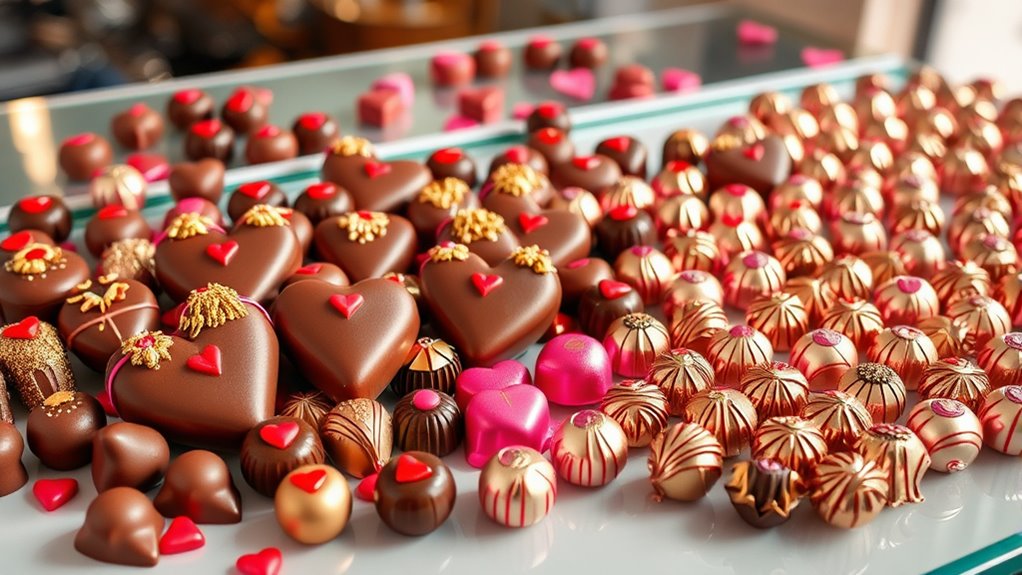
The commercialization of Valentine’s Day transformed chocolates from a simple gift into a highly profitable industry, fueling mass production and widespread marketing campaigns. Today, major brands flood stores with heart-shaped boxes and themed packaging, making chocolates a must-have gift. You’ll notice how advertising emphasizes romance and luxury, encouraging impulse buys. Large-scale companies introduced seasonal promotions, boosting sales each February. Consumers now associate chocolates with love, thanks to clever marketing strategies.
- Branding collaborations with celebrities
- Limited-edition packaging for holidays
- Targeted advertising campaigns
- Increased availability in retail chains
- Promotional discounts around Valentine’s Day
Modern Celebrations and the Symbolism of Chocolate Today
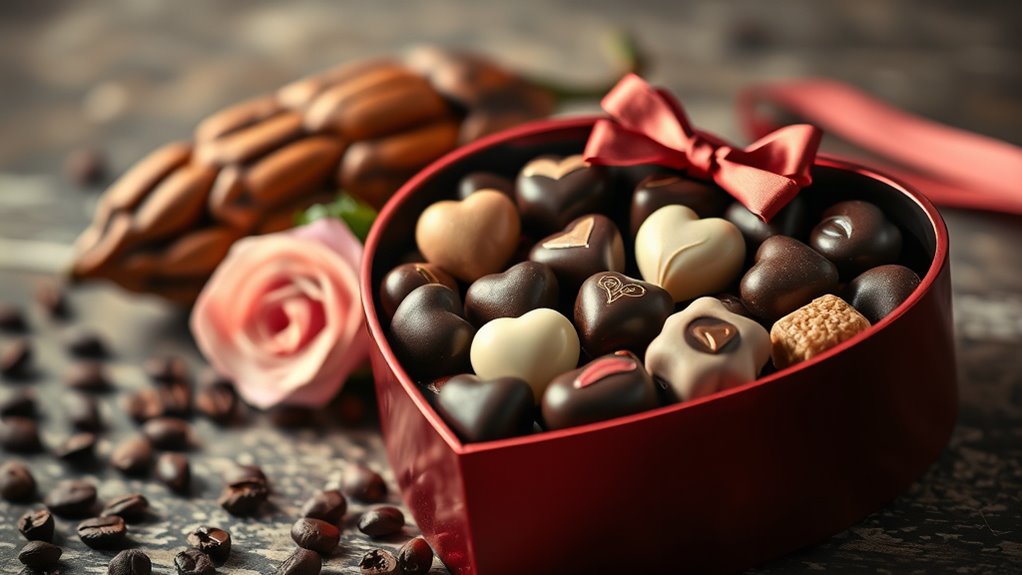
Today, you often give chocolates as a romantic gift on Valentine’s Day, continuing a long-standing tradition. Many see chocolate as a symbol of love and affection, making it a meaningful gesture. This tradition keeps evolving, but the core idea remains the same: chocolate represents your feelings.
Romantic Gift Tradition
Because of its rich history as a symbol of love and affection, chocolate has become a staple gift on Valentine’s Day. When you give someone chocolate, you’re not just offering a sweet treat—you’re sharing a gesture rooted in centuries of tradition. Today, it’s common to see heart-shaped boxes, personalized messages, and luxury chocolates exchanged between lovers. This tradition emphasizes thoughtfulness and intimacy, making your gift more meaningful.
Some ways people celebrate this romantic gesture include:
- Choosing artisanal chocolates to show extra care
- Including handwritten love notes
- Gifting chocolates paired with flowers
- Giving chocolates with symbolic packaging
- Creating custom chocolate assortments
These gestures deepen the connection, symbolizing love, appreciation, and desire.
Chocolate as Love Symbol
Modern celebrations continue to reinforce chocolate’s status as a symbol of love, with couples and friends exchanging it to express affection and appreciation. Today, giving chocolate on Valentine’s Day isn’t just about the sweet taste but also about conveying deep emotional connection. The act of sharing chocolates symbolizes care, thoughtfulness, and desire to bring happiness. Specially wrapped chocolates or personalized boxes often enhance this gesture, making it more meaningful. As a universal symbol of love, chocolate’s rich, indulgent qualities evoke warmth and intimacy. Its association with romance remains strong across cultures, making it a popular gift choice. Whether in heart-shaped boxes or artisanal treats, chocolate’s role continues to celebrate love’s sweetness and the bonds between loved ones.
Cultural Variations of Chocolate and Love Around the World
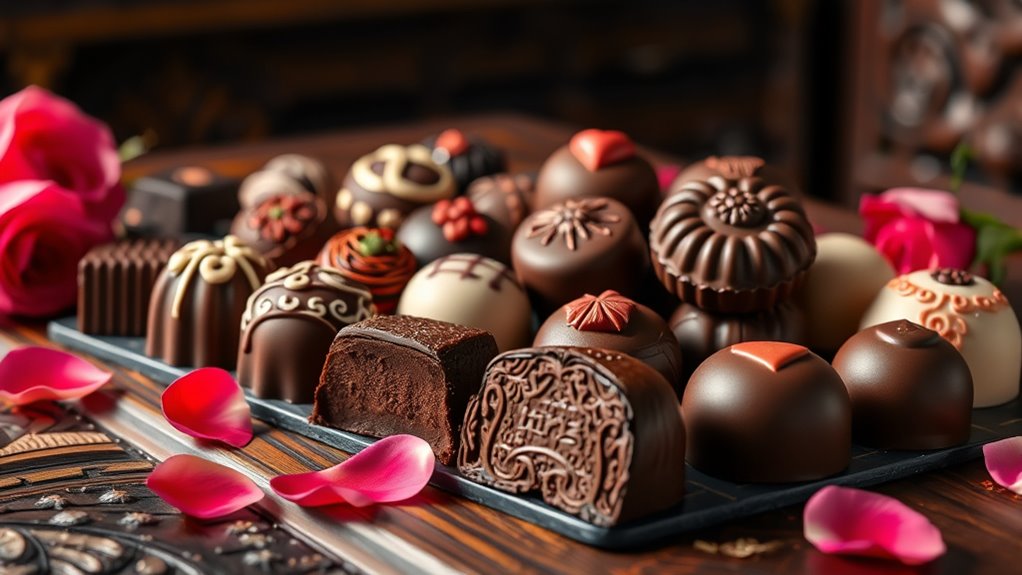
Across different cultures, chocolate is more than just a sweet treat; it symbolizes love, affection, and celebration in unique ways. In Mexico, couples exchange spicy chocolate confections during Día de los Muertos, blending tradition and romance. In Ghana, gifting premium cocoa signifies wealth and admiration. Japan celebrates Valentine’s Day with women giving chocolates to men, often differentiating between “giri” (obligatory) and “honmei” (true love) chocolates. In Belgium, chocolates are a symbol of luxury and romance, often gifted on special occasions. Meanwhile, in West Africa, sharing cocoa demonstrates community and affection. You might notice these variations reflect local customs, values, and histories, making chocolate a versatile symbol of love worldwide. Each culture adds its own flavor, turning chocolate into a global language of connection.
Frequently Asked Questions
When Did Chocolate First Become Associated With Romantic Love?
You might wonder when chocolate first linked to romantic love. It started in the 19th century when chocolate became more accessible and popular. People believed it had aphrodisiac properties, so lovers gave chocolates as a sweet gesture of affection. Over time, this tradition grew, and by the early 20th century, chocolates became a staple gift on Valentine’s Day. Today, you associate chocolates with love and romance, continuing the sweet tradition.
How Did Chocolate Become a Symbol of Valentine’s Day Specifically?
You might be surprised to learn that chocolate’s link to Valentine’s Day results from a fortunate coincidence. In the 19th century, chocolate became more accessible and romanticized through marketing and gift-giving traditions. As couples exchanged chocolates and confections, it naturally grew into a symbol of love and affection. Today, you see it everywhere, reinforcing the idea that sharing chocolate is a sweet way to express your feelings on this special day.
Were There Any Early Cultures That Used Chocolate for Love Rituals?
You probably wonder if any early cultures used chocolate in love rituals. Ancient civilizations like the Aztecs and Mayans definitely did. They valued cacao beans highly, believing they had divine or aphrodisiac powers. Aztecs used cacao in sacred ceremonies and as a symbol of love and fertility. So yes, you can see that chocolate’s connection to love and ritual goes way back, long before modern Valentine’s Day traditions.
How Has Chocolate’s Romantic Symbolism Evolved Over Centuries?
Passion and pleasure have perpetually painted chocolate’s romantic reputation. Over centuries, you’ve seen it shift from sacred symbol to sweet sign of love. Today, you associate chocolate with heartfelt gestures, romantic rituals, and irresistible indulgence. Its allure lingers, evolving with cultural customs and personal connections. As you share chocolates, you participate in a timeless tradition—transforming simple sweetness into a symbol of love that lasts through generations.
What Are Some Unique Cultural Traditions Involving Chocolate and Love Worldwide?
You’ll find that around the world, chocolate’s role in love customs is truly diverse. In Mexico, couples exchange “Chocolate Hearts” during Día de los Muertos. In Japan, women gift chocolates to loved ones on Valentine’s Day, followed by men reciprocating on White Day. In Ghana, chocolate is part of marriage ceremonies, symbolizing fertility and unity. These traditions highlight chocolate’s deep cultural significance in expressing love globally.
Conclusion
So, next time you unwrap a piece of chocolate on Valentine’s Day, remember its rich history rooted in ancient rituals, European luxury, and romantic symbolism. It’s more than just a sweet treat; it’s a centuries-old tradition that connects cultures and emotions. Isn’t it amazing how something so simple can carry so much meaning? Whether you’re celebrating love or just indulging, chocolates remind us of the timeless power of connection.
